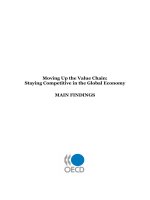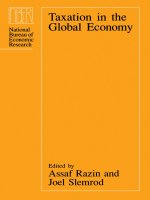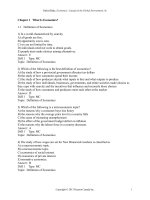Lecture Macroeconomics - Chapter 5: Canada in the global economy
Bạn đang xem bản rút gọn của tài liệu. Xem và tải ngay bản đầy đủ của tài liệu tại đây (257.5 KB, 38 trang )
Canada in the Global
Economy
Chapter 5
SLIDES PREPARED BY JUDITH SKUCE, GEORGIAN COLLEGE
© 2002 McGraw-Hill Ryerson Ltd.
Chapter 5
In this chapter you will learn
That trade is crucial to Canada’s economic
well-being
The importance of specialization &
comparative advantage in international trade
How the value of a currency is established on
foreign exchange markets
The economic costs of trade barriers
About multilateral trade agreements & free
trade zones
© 2002 McGraw-Hill Ryerson Ltd.
Chapter 5
Chapter 5 Topics
International Linkages
Canada & World Trade
Back to the Circular Flow Model
Specialization & Comparative Advantage
Foreign Exchange Market
Government & Trade
Multilateral Trade Agreements & FreeTrade Zones
Increased Global Competition
© 2002 McGraw-Hill Ryerson Ltd.
Chapter 5
International Linkages
Figure 5-1
Goods & Services
Capital & Labour
Canadian
Canadian
Economy
Economy
Info & Technology
Other
Other
National
National
Economies
Economies
Money
© 2002 McGraw-Hill Ryerson Ltd.
Chapter 5
Chapter 5 Topics
International Linkages
Canada & World Trade
Back to the Circular Flow Model
Specialization & Comparative Advantage
Foreign Exchange Market
Government & Trade
Multilateral Trade Agreements & FreeTrade Zones
Increased Global Competition
© 2002 McGraw-Hill Ryerson Ltd.
Chapter 5
Canada & World Trade
volume of international trade has
been increasing
• absolutely
• relative to GDP
for Canada & the world
© 2002 McGraw-Hill Ryerson Ltd.
Chapter 5
GLOBAL PERSPECTIVE 5.1
Exports of goods & services as % of GDP, 1999
The Netherlands
Canada
New Zealand
Germany
Italy
France
United Kingdom
Canada’s exports make up almost
Japan
40% of domestic output of goods &
services
0
10
20
30
40
50
U.S.
© 2002 McGraw-Hill Ryerson Ltd.
Chapter 5
60
Canada & World Trade
Canada is dependent on other
countries for many goods
imported goods compete with
Canadian goods in many
markets
many Canadian industries rely
on foreign markets
© 2002 McGraw-Hill Ryerson Ltd.
Chapter 5
Canada & World Trade
Canada has a trade surplus in
goods
Canada has a trade deficit in
services
Canada imports goods in some
of the same categories it exports
© 2002 McGraw-Hill Ryerson Ltd.
Chapter 5
Principal Canadian Exports of Goods, 2000
Table 5-1
% of total
exports
Machinery & equipment
25
Automotive products
23
Industrial goods &
materials
15
Forestry products
10
Energy products
13
Agricultural & fishing
products
7
© 2002 McGraw-Hill Ryerson Ltd.
Chapter 5
Principal Canadian Imports of Goods, 2000
Table 5-1
% of total
imports
Machinery & equipment
34
Automotive products
21
Industrial goods &
materials
19
Consumer goods
11
Agricultural & fishing
products
5
Energy products
5
© 2002 McGraw-Hill Ryerson Ltd.
Chapter 5
Canada & World Trade
Canada trades with:
• the US
• other advanced nations
© 2002 McGraw-Hill Ryerson Ltd.
Chapter 5
Canadian Exports & Imports of Goods by Area, 2000
Table 5-2
Exports
Imports
% of total
% of total
to
from
US
86
US
74
EU
5
EU
9
Japan
3
Japan
3
other
6
other
14
© 2002 McGraw-Hill Ryerson Ltd.
Chapter 5
Canada & World Trade
Rapid trade growth because of:
Transportation Technology
Communications Technology
General Decline in Tariffs
© 2002 McGraw-Hill Ryerson Ltd.
Chapter 5
Participants in Trade
Who trades?
North America, Japan & Western
Europe
New Participants
© 2002 McGraw-Hill Ryerson Ltd.
Chapter 5
GLOBAL PERSPECTIVE 5.2
Comparative Exports, 1999
United States
Germany
Japan
France
United Kingdom
Canada
Italy
Netherlands
China
Belgium
Korea, Rep. of
Mexico
Taipei, Chinese
Singapore
Spain
0
100
200
300
400
500
600
700
US $ billions
© 2002 McGraw-Hill Ryerson Ltd.
Chapter 5
Chapter 5 Topics
International Linkages
Canada & World Trade
Back to the Circular Flow Model
Specialization & Comparative Advantage
Foreign Exchange Market
Government & Trade
Multilateral Trade Agreements & FreeTrade Zones
Increased Global Competition
© 2002 McGraw-Hill Ryerson Ltd.
Chapter 5
Back to the Circular Flow Model
INPUT FACTORS
RESOURCES
EXPENDITURES
GOODS
GOODS
CANADIAN
GOVERNMENT
NET
TAXES
EXPENDITURES
U
CANADIAN
PRODUCT
MARKETS
E
GOODS & SERVICES
N
EV
EN
GOODS & SERVICES
GOODS & SERVICES
C
O
R
NET
TAXES
$
$
CANADIAN
HOUSEHOLDS
N
CANADIAN
BUSINESSES
Foreign Expenditures
Cdn. Exports
© 2002 McGraw-Hill Ryerson Ltd.
ES
IO
RESOURCES
C
O
M
SU
M
$
C
O
CANADIAN
RESOURCE
MARKETS
IN
PT
ST
S
$
REST
OF THE
WORLD
Cdn. Imports
Cdn. Expenditures
Chapter 5
Chapter 5 Topics
International Linkages
Canada & World Trade
Back to the Circular Flow Model
Specialization & Comparative Advantage
Foreign Exchange Market
Government & Trade
Multilateral Trade Agreements & FreeTrade Zones
Increased Global Competition
© 2002 McGraw-Hill Ryerson Ltd.
Chapter 5
Specialization & Comparative
Advantage
Basic Principle
• Specialization & international trade
increase the productivity of a nation’s
resources & allow for greater total
output than otherwise possible
Comparative Costs
© 2002 McGraw-Hill Ryerson Ltd.
illustrated…
Chapter 5
MEXICO
TABLE 5-3
PRODUCTION ALTERNATIVES
Product
A
Corn
Soybeans
CANADA
TABLE 5-4
B
C
D
Soybeans:
E
Canada
has
20
24
40
60
comparative
15
10
9
5
0
advantage in
soybeans
PRODUCTION ALTERNATIVES
0
Product
A
B
C
D
E
Corn
0
30
33
60
90
Soybeans
30
20
19
10
0
© 2002 McGraw-Hill Ryerson Ltd.
Mexico must
give up 4
tonnes of
corn for 1
tonne of
soybeans
Canada
must give up
3 tonnes of
corn for 1
tonne of
soybeans
Chapter 5
MEXICO
TABLE 5-3
PRODUCTION ALTERNATIVES
Product
A
Corn
Soybeans
CANADA
TABLE 5-4
B
C
D
Corn:
E
Mexico
has
20
24
40
60
comparative
15
10
9
5
0
advantage in
corn
PRODUCTION ALTERNATIVES
0
Product
A
B
C
D
E
Corn
0
30
33
60
90
Soybeans
30
20
19
10
0
© 2002 McGraw-Hill Ryerson Ltd.
Mexico must
give up 1/4
tonne of
soybeans
for 1 tonne
of corn
Canada
must give up
1/3 tonne of
soybeans
for 1 tonne
of corn
Chapter 5
Specialization & Comparative
Advantage
Basic Principle
• Specialization & international trade
increase the productivity of a nation’s
resources & allow for greater total
output than otherwise possible
Comparative Costs
Terms of Trade
• must be mutually beneficial
© 2002 McGraw-Hill Ryerson Ltd.
Chapter 5
Specialization & Comparative
Advantage
Basic Principle
• Specialization & international trade
increase the productivity of a nation’s
resources & allow for greater total
output than otherwise possible
Comparative Costs
Terms of Trade
Gains from Specialization & Trade
© 2002 McGraw-Hill Ryerson Ltd.
illustrated…
Chapter 5
Table 5-6
Canada
Mexico
corn
soybeans
corn
soybeans
33
19
24
9
0
30
60
0
+35
-10
-35
+10
Outputs
available after
trade
35
20
25
10
Gains from
specialization
& trade
2
1
1
1
Outputs
before
specialization
Outputs after
specialization
Amounts
traded
© 2002 McGraw-Hill Ryerson Ltd.
Chapter 5









